Tea dyeing is an easy way to give common white thread a lovely vintage look.
Dyeing can be done either before knitting or afterwards. The advantage of dyeing the completed item is that you will be dyeing the exact amount of thread that was needed to complete the piece. This is the approach I will be demonstrating with Tea-time Serviette.
Plan that tea dyeing will usually change a white thread into a soft glowing tan or light brown. However, color can also vary depending on variety of tea, as well as strength of tea solution and soaking time. Over-dyeing other colors of thread can also have pleasant effects.
If you are concerned about ruining your knitted piece, first use some un-knit yarn/thread as a test to see what you might get with the tea and solution you prepare.
A caveat is that dyeing with tea works most effectively with natural fibers like cotton and wool. Other man-made fibers made from natural products, like rayon and Tencel can also be tea–dyed. Attempting to dye synthetics like acrylic and polyester will meet with disappointment and failure without addition of industrial chemicals you really don’t want to have in your house. Stick with threads/yarns made predominantly of natural fibers or man-made fibers of natural products, and you shouldn’t have any problems.
Choosing Tea
Common, cheap tea such as used for iced tea works fine. Tea bags are convenient as the leafy bits are already confined. Just make sure any tea bags you will use are not leaking, since you do not want leaf matter getting embedded in your fabric.
The number of tea bags you need depends on the bag size and how dark you want your color. More tea = darker color. You can always make a darker color later by adding more tea or soaking longer, so there is no need to go overboard on amount of tea you use to begin with. For our small Tea-time Serviette project, a family size tea bag, or 6 – 8 individual-cup-size tea bags should be sufficient.
Other Supplies
Besides the tea, you only need a non-staining bowl and some water.
Make sure the bowl you use is made of a non-reactive material such as glass or stainless steel. Some metals such as copper or iron can react with the acid in tea and produce muddy results.
I just use tap water. But if you know you are in an area with especially hard water, it might be better to use a filtered water to avoid any surprises.
Use only as much water as needed to cover the fabric you will be dyeing. This way you are not diluting the strength of the dye solution and wasting tea. For the small Tea-time Serviette, I used a scant 2 cups of water in this glass bowl.
Preparing the Tea Dye Solution
Steep the tea bag(s) by placing in the bowl of water.
There is no need to heat the water to do this. The tea will emit its color without this extra step. And since we aren’t going to be drinking the tea solution anyway, the flavor profile is not our top priority, lol.
If you are anxious to get on with the show, you can make the steeping process go faster by dipping the bag up and down in the water by its string.
Otherwise, just be patient and let time do its thing. Continue steeping until the water darkens to a shade somewhat darker than final desired color (fabric will dry lighter).
When done steeping, lift tea bag out of water and set it aside in case you want to use it later to darken the solution further.
Dyeing the Knitted Lace Fabric
Good practice would be to pre-wash the fabric to remove sizing, oil, dirt, etc. so that it does not interfere with the dyeing process. If you do pre-wash, extract as much water as possible before dropping the fabric in the dye solution so as to not dilute the color.
If you are confident your fabric is already clean, you can just drop it dry into the dye solution.
Totally submerge the fabric in the dye solution and let stay there. Be patient, if you can, lol!
You can periodically check the progress after 45 minutes or so by lifting out a corner. Remember that the fabric will dry to a lighter shade.
Strengthening the Dye Solution
Longer soaking will darken the color without the expense of adding more tea. But if you are in a hurry and don’t want to wait overnight, you can strengthen the dye solution with more tea for speedier results. Also, you can always go back and dye again for a darker shade if you find that the fabric dried too light the first time.
Remember that tea bag you set aside? Go ahead and add it in along with other tea bag(s) to the bowl of water. Steep until desired darker shade, then remove tea bags as before.
Submerge the already-dyed fabric again.
Re-check periodically as before for depth of color. Remember that the fabric will be lighter when finished.
Finishing the Dyed Knitted Lace Fabric
Submerge the dyed fabric in a pan of hot tap water and let stay there for a couple of minutes.
Rinse gently then remove excess water. Finger block on a flat surface and let dry thoroughly.
If you’ve used beads as I did here, you will see how they resist the dye, providing a nice contrast as planned for the edging of the dyed Tea-time Serviette.
Care of Tea-dyed Fabrics
Your tea-dyed fabric will hold up better and longer when washed by hand with mild fiber wash or shampoo. Beware: avoid detergents that are designed to remove stains.
Other reasons to dye with tea
Why dye with tea? Besides vintage effects such as in this month’s Tea-time Serviette project, tea can be used to over-dye and tone down outrageous colors, or bring more harmony to disparate colors. Tea dyeing can be a handy complementary technique to lace knitting using variegated yarns, since lace patterns show up better in color mixes with close tonal values rather than those with high contrast.
Have you dyed with tea before? Can you think of some other ways in which tea dyeing can be used?

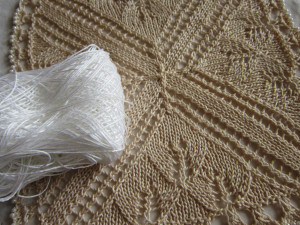
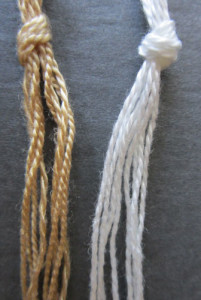
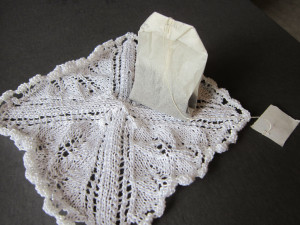
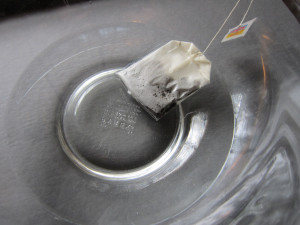
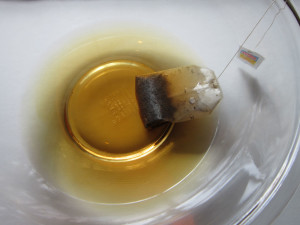
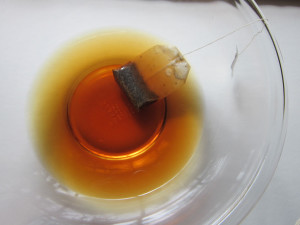
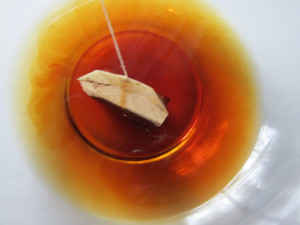
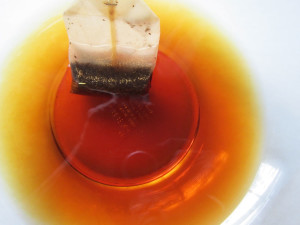
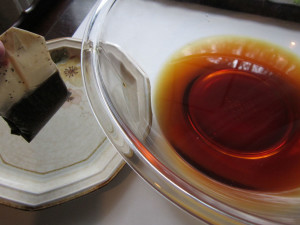
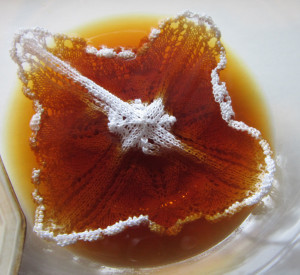
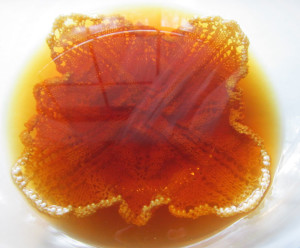
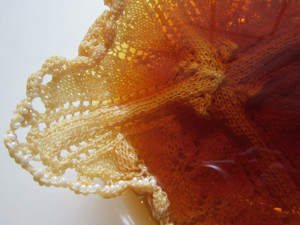
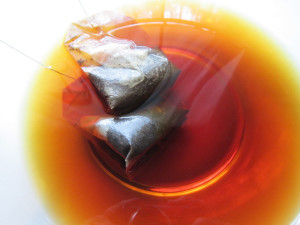
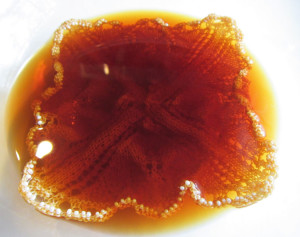
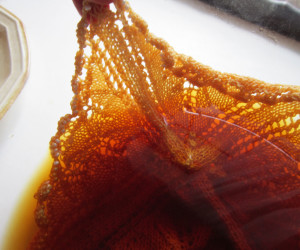
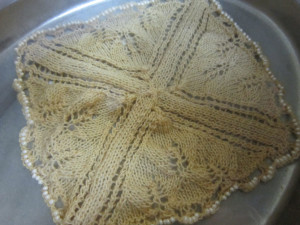
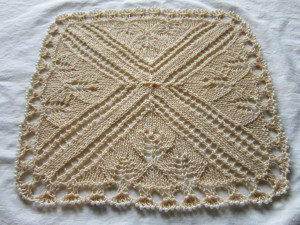
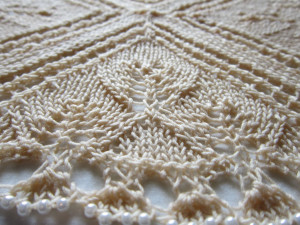

 HeartStrings FiberArts
HeartStrings FiberArts Knitting Bits of Lace on Facebook
Knitting Bits of Lace on Facebook Ravelry Store
Ravelry Store
Thank you for sharing the detailed tutorial on tea dying. A lot of work went into this. Thank you!
You are welcome. Glad it is helpful and you like it!